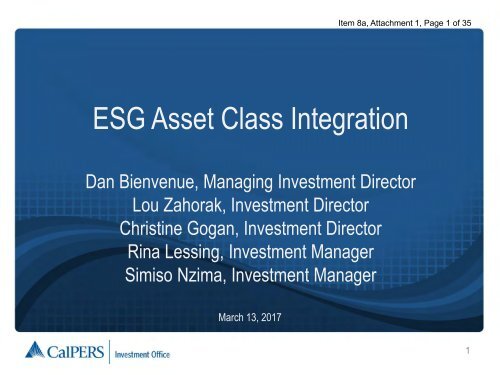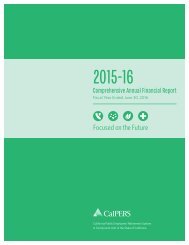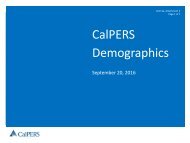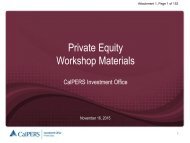ESG Asset Class Integration
dcvp309Gq2R
dcvp309Gq2R
Create successful ePaper yourself
Turn your PDF publications into a flip-book with our unique Google optimized e-Paper software.
Item 8a, Attachment 1, Page 1 of 35<br />
<strong>ESG</strong> <strong>Asset</strong> <strong>Class</strong> <strong>Integration</strong><br />
Dan Bienvenue, Managing Investment Director<br />
Lou Zahorak, Investment Director<br />
Christine Gogan, Investment Director<br />
Rina Lessing, Investment Manager<br />
Simiso Nzima, Investment Manager<br />
March 13, 2017<br />
1
<strong>ESG</strong> <strong>Asset</strong> <strong>Class</strong> <strong>Integration</strong> Item 8a, Attachment 1, Page 2 of 35<br />
<strong>ESG</strong> <strong>Asset</strong> <strong>Class</strong> <strong>Integration</strong> | Agenda<br />
• <strong>ESG</strong> Strategic Plan<br />
– Summary and Timeline<br />
– Key Initiatives<br />
• Governance Framework<br />
– Organizational Realignment<br />
– ISG and the Subcommittee / Working Group Structure<br />
• <strong>Integration</strong> and Manager Expectations Deep-Dive<br />
2
<strong>ESG</strong> <strong>Asset</strong> <strong>Class</strong> <strong>Integration</strong> Item 8a, Attachment 1, Page 3 of 35<br />
Summary of the 5-year plan | Governance & Sustainability<br />
Environmental Social Governance<br />
S<br />
T<br />
R<br />
A<br />
T<br />
E<br />
G<br />
I<br />
C<br />
C<br />
O<br />
R<br />
E<br />
Data and corporate reporting standards (includes<br />
water risk)<br />
Data and corporate reporting standards (includes human<br />
capital)<br />
Manager Expectations (includes water risk) Manager Expectations Manager Expectations<br />
Research<br />
• Sustainable Investment Research Initiative<br />
(SIRI)<br />
Engage 80 PRI Montreal Pledge Companies<br />
(identify risk candidates)<br />
• Carbon Footprinting – Total fund<br />
• Thermal Coal Companies – (SB185)<br />
Research<br />
• SIRI<br />
• Diversity<br />
• Income inequality (action plan if warranted)<br />
Diversity and Inclusion<br />
• Engagement<br />
• Voting<br />
• 3D<br />
• Advocacy<br />
• Responsible Contractor Program<br />
• Supply Chain Activities<br />
Work through Partnerships to leverage resources and impact<br />
• Corporate Engagements<br />
• Federal and Legislative Guidelines<br />
• Sustainability Report<br />
• Response to Ad Hoc Media and Stakeholder Requests<br />
Data and corporate reporting standards (focusing on<br />
the long-term)<br />
Research<br />
• Topics from Global Governance Principles<br />
Review<br />
Private Equity Fee and Profit Sharing Transparency<br />
(including AB 2833)<br />
• Proxy Voting<br />
• Shareowner Campaigns (Proxy Access/Majority<br />
Voting)<br />
• Focus List<br />
• Divestment: Mandates, Policy & Principles<br />
3
<strong>ESG</strong> <strong>Asset</strong> <strong>Class</strong> <strong>Integration</strong> Item 8a, Attachment 1, Page 4 of 35<br />
Proposed Timeline for Developing a 3-5 Year Strategic Plan<br />
4
<strong>ESG</strong> <strong>Asset</strong> <strong>Class</strong> <strong>Integration</strong> Item 8a, Attachment 1, Page 5 of 35<br />
Key Initiatives<br />
Strategic<br />
1. Data and Corporate Reporting<br />
Standards<br />
2. Engage UN PRI Montreal<br />
Pledge Companies<br />
3. Diversity and Inclusion<br />
4. Manager Expectations<br />
5. Research<br />
6. Private Equity Fee and Profit<br />
Sharing Transparency<br />
Core<br />
1. Carbon Footprinting<br />
2. Responsible Contractor Policy<br />
3. Supply Chain Activities<br />
4. Proxy Voting<br />
5. Shareowner Campaigns<br />
6. Focus List<br />
7. Divestment: Mandates, Policy and Principles,<br />
including Thermal coal companies SB 185<br />
8. Corporate Engagements<br />
9. Partnerships<br />
10. Legislative Guidelines<br />
11. Sustainability Report<br />
5
<strong>ESG</strong> <strong>Asset</strong> <strong>Class</strong> <strong>Integration</strong> Item 8a, Attachment 1, Page 6 of 35<br />
New Organizational Alignment – <strong>ESG</strong><br />
6
<strong>ESG</strong> <strong>Asset</strong> <strong>Class</strong> <strong>Integration</strong> Item 8a, Attachment 1, Page 7 of 35<br />
Investment Strategy Group (ISG) Subcommittees<br />
Trust-Level Risk and Attribution<br />
Co-Chairs: Kevin Winter, Michael Krimm<br />
Ensures that investment risks are<br />
intended, understood, and<br />
compensated<br />
Investment Strategy<br />
Group<br />
Portfolio Allocation<br />
Chair: Eric Baggesen<br />
Provides organized approach to<br />
making asset class rebalance<br />
and tactical position decisions<br />
Governance and Sustainability<br />
Co-Chairs: Dan Bienvenue, Anne Simpson<br />
Ensures that <strong>ESG</strong> risk<br />
considerations are integrated<br />
into the investment-decision<br />
making process<br />
Trust-Level Investment Review<br />
Chair: Paul Mouchakkaa<br />
Provides a trust-level decision<br />
process and framework for the review<br />
of non-core programs, business<br />
models, assets and investments<br />
7
<strong>ESG</strong> <strong>Asset</strong> <strong>Class</strong> <strong>Integration</strong> Item 8a, Attachment 1, Page 8 of 35<br />
Governance & Sustainability Subcommittee | Purpose<br />
Goal and Functions<br />
Advises and informs the Investment Strategy Group (ISG) on the integration of the<br />
CalPERS Investment Beliefs, in particular environmental, social, and governance (<strong>ESG</strong>)<br />
risk and opportunity considerations into the Total Fund.<br />
• Grounded in economics and fiduciary duty<br />
• Governance around Core and Strategic work<br />
• Research on emerging topics and trends<br />
• Broad INVO ownership of agenda and activities in <strong>ESG</strong><br />
8
<strong>ESG</strong> <strong>Asset</strong> <strong>Class</strong> <strong>Integration</strong> Item 8a, Attachment 1, Page 9 of 35<br />
Governance & Sustainability Subcommittee | Membership<br />
Co-Chairs:<br />
• Dan Bienvenue, Managing Investment Director, Global Equity<br />
• Anne Simpson, Investment Director, Sustainable Investment<br />
Global Equity<br />
Global Fixed<br />
Income<br />
<strong>Asset</strong> Allocation/<br />
Risk<br />
Sustainable<br />
Investment<br />
Enterprise<br />
Representatives<br />
• Simiso Nzima, Investment Manager<br />
• Stuart Hall, Investment Officer III<br />
• Lou Zahorak, Investment Director<br />
• Paul Kramer, Investment Manager<br />
• Alison Li, Investment Manager<br />
• Dianne Sandoval, Investment Manager<br />
• Divya Mankikar, Investment Officer III<br />
• Tiffany Pokk, Investment Officer II<br />
Real <strong>Asset</strong>s<br />
Private Equity<br />
Investment<br />
Compliance &<br />
Operational<br />
Risk<br />
Execution<br />
Services and<br />
Strategy (ESS)<br />
• Gretchen Zeagler, Assistant Chief, Legislative Affairs Division<br />
• Megan White, Information Officer II, Public Affairs<br />
• Salony Mehrok, Senior Attorney, Legal Office<br />
• Rina Lessing, Investment Manager<br />
• Beth Richtman, Investment Manager<br />
• Christine Gogan, Investment Director<br />
• Liliya Kamalova, Investment Officer III<br />
• Kit Crocker, Investment Director<br />
• Anna Morrison, Investment Officer I<br />
• Don Pontes, Investment Director<br />
• James Andrus, Investment Manager<br />
9
<strong>ESG</strong> <strong>Asset</strong> <strong>Class</strong> <strong>Integration</strong> Item 8a, Attachment 1, Page 10 of 35<br />
Governance & Sustainability | Working Groups<br />
Financial Markets Working Group<br />
Lead: Don Pontes<br />
Advise on Legislative and<br />
Regulatory Advocacy<br />
Governance &<br />
Sustainability<br />
Subcommittee<br />
Proxy Working Group<br />
Lead: Simiso Nzima<br />
Assess Proxy Voting and<br />
Corporate Engagement<br />
Activities<br />
Research Working Group<br />
Lead: Anne Simpson<br />
Organized approach to<br />
understanding research and<br />
emerging trends in <strong>ESG</strong><br />
10
<strong>ESG</strong> <strong>Asset</strong> <strong>Class</strong> <strong>Integration</strong><br />
Global Fixed Income<br />
Lou Zahorak, Investment Director<br />
11
<strong>ESG</strong> <strong>Asset</strong> <strong>Class</strong> <strong>Integration</strong> Item 8a, Attachment 1, Page 12 of 35<br />
The Six UN PRI Principles<br />
1<br />
We will incorporate <strong>ESG</strong> issues into<br />
investment analysis and decisionmaking<br />
processes.<br />
5<br />
We will work together to enhance out<br />
effectiveness in implementing the<br />
Principles.<br />
2<br />
We will be active owners and incorporate<br />
<strong>ESG</strong> issues into our ownership policies<br />
and practices.<br />
6<br />
We will each report on our activities and<br />
progress towards implementing the<br />
Principles.<br />
3<br />
We will seek appropriate disclosure on<br />
<strong>ESG</strong> issues by the entities in which we<br />
invest.<br />
4<br />
We will promote acceptance and<br />
implementation of the principles within<br />
the investment industry.<br />
12
<strong>ESG</strong> <strong>Asset</strong> <strong>Class</strong> <strong>Integration</strong> Item 8a, Attachment 1, Page 13 of 35<br />
Global Fixed Income <strong>ESG</strong> <strong>Integration</strong><br />
Principle 1: We will incorporate <strong>ESG</strong> issues into investment analysis and decisionmaking<br />
processes.<br />
Global Fixed Income Actions:<br />
Policy required: Exclude tobacco bonds from portfolios<br />
• Use <strong>ESG</strong>-related tools, metrics, and analyses<br />
– Use MSCI <strong>ESG</strong> scores to assess <strong>ESG</strong> related risks in our Internal Credit portfolios<br />
– Use MSCI carbon data to complete Carbon Footprint comparison of Internal Credit Portfolio relative to<br />
our benchmark<br />
– Use Covenant Review to provide insight into understanding Bondholder rights stated in Bond Indentures<br />
• Assess the capabilities of internal and external investment managers to incorporate <strong>ESG</strong> issues<br />
– Quarterly review of our Internal Credit portfolio positions to <strong>ESG</strong> scores<br />
– Utilize various social measures for Internal Sovereign portfolios – Corruptions, Transparency, Inequality<br />
Indices<br />
– Completed survey of External Manager integration of <strong>ESG</strong> into their research and portfolio process<br />
• Ask investment service providers to integrate <strong>ESG</strong> factors into evolving research and analysis<br />
– Barclays Research: Governance scores have strongest link to performance<br />
13
<strong>ESG</strong> <strong>Asset</strong> <strong>Class</strong> <strong>Integration</strong> Item 8a, Attachment 1, Page 14 of 35<br />
Global Fixed Income <strong>ESG</strong> <strong>Integration</strong><br />
Principle 1: We will incorporate <strong>ESG</strong> issues into investment analysis and<br />
decision-making processes.<br />
Global Fixed Income Actions (continued):<br />
Specific portfolio decisions and engagements<br />
• Sold Viacom and CBS bonds without change of control language where Governance event risk<br />
was identified<br />
• Engaged General Electric with other bondholders due to concerns about fair treatment and<br />
valuation on preferred securities exchange<br />
• Reduced exposure to South Africa, Malaysia, and Turkey due to financial risks associated with<br />
high corruption and low Transparency Scores<br />
• Engaged with BHP on their governance of and financial risks associated with Samarco – Brazilian<br />
mining accident that resulted in environmental damage and civilian deaths<br />
Principle 3: We will seek appropriate disclosure on <strong>ESG</strong> issues.<br />
Global Fixed Income Actions:<br />
• Contributed to SASB assessment of various industry disclosure practices<br />
14
<strong>ESG</strong> <strong>Asset</strong> <strong>Class</strong> <strong>Integration</strong> Item 8a, Attachment 1, Page 15 of 35<br />
Global Fixed Income <strong>ESG</strong> <strong>Integration</strong> | Looking Forward<br />
Survey Summary<br />
Surveyed<br />
• 4 High Yield Credit Managers<br />
• 5 International Fixed Income Managers<br />
– 8 of 9 are UNPRI Signatories<br />
– All 9 are considering <strong>ESG</strong> factors in their investment process<br />
Conclusions Drawn<br />
• As signatories the Managers are moving toward UNPRI integration requirements<br />
• Some have more formalized organizational structure and roles to implement the<br />
integration process<br />
Next Steps<br />
• Complete Carbon Footprint of Internal Corporate Fixed Income portfolios<br />
• By year end 2017, update Global Fixed Income manager investment guidelines to<br />
include requirements to incorporate <strong>ESG</strong> factors into investment process<br />
15
<strong>ESG</strong> <strong>Asset</strong> <strong>Class</strong> <strong>Integration</strong><br />
Private Equity<br />
Christine Gogan, Investment Director<br />
16
<strong>ESG</strong> <strong>Asset</strong> <strong>Class</strong> <strong>Integration</strong> Item 8a, Attachment 1, Page 17 of 35<br />
Private Equity <strong>ESG</strong> <strong>Integration</strong><br />
Principle 1: We will incorporate <strong>ESG</strong> issues into investment analysis and<br />
decision-making processes.<br />
Private Equity Actions:<br />
• During the investment monitoring phase, PE staff engages with the GPs to<br />
understand how <strong>ESG</strong> policies are implemented, how <strong>ESG</strong> is monitored across<br />
investments, and how <strong>ESG</strong> decisions are communicated to the LPs.<br />
• During the due diligence process, PE staff asks questions concerning the GP’s<br />
<strong>ESG</strong> practices including whether a formal <strong>ESG</strong> policy exists as well as how <strong>ESG</strong><br />
matters are factored into investment decision making by the GP. These matters are<br />
discussed as part of the investment decision making process.<br />
17
<strong>ESG</strong> <strong>Asset</strong> <strong>Class</strong> <strong>Integration</strong> Item 8a, Attachment 1, Page 18 of 35<br />
Private Equity <strong>ESG</strong> <strong>Integration</strong><br />
Principle 4: We will promote acceptance and implementation of the Principles within<br />
the investment industry.<br />
Private Equity Actions:<br />
• Underwriting: Understand how GPs incorporate <strong>ESG</strong> into their investment selection by<br />
including several of the UNPRI Principles in the CalPERS due diligence questionnaire.<br />
• Monitoring: Staff proactively inquires of the top 10 managers by assets under<br />
management about <strong>ESG</strong> practices and issues at the Limited Partner Advisory<br />
Committee (LPAC) meeting. Further, staff is documenting all <strong>ESG</strong>-related issues in<br />
periodic meeting notes and discussing practices across the Private Equity Portfolio.<br />
• Industry Engagement: CalPERS PE staff has been engaged with UNPRI to provide<br />
feedback in creating and modifying the Principles based on feedback gained from<br />
monitoring PE Managers. Staff also participates in the broader industry dialogue with<br />
other limited partners and emphasizes the importance of collaborating together to<br />
support industry standards that strive to assist LPs in monitoring <strong>ESG</strong> issues uniformly<br />
across private equity funds.<br />
18
<strong>ESG</strong> <strong>Asset</strong> <strong>Class</strong> <strong>Integration</strong> Item 8a, Attachment 1, Page 19 of 35<br />
GP Level of Engagement on <strong>ESG</strong><br />
• A vast majority of commitments made in the last 16 months include an <strong>ESG</strong> section<br />
in the Side Letter or Limited Partnership Agreement.<br />
• Larger PE firms are leading the way with designated sustainability staff and annual<br />
sustainability reports. Several smaller PE firms are working towards creating an<br />
<strong>ESG</strong> policy.<br />
• Based on recent experiences, CalPERS is typically the LP that actively brings up<br />
the <strong>ESG</strong> topic at annual meetings and LPAC meetings.<br />
*Data based on PE commitments made from 06/30/2015 through 10/31/2016<br />
19
<strong>ESG</strong> <strong>Asset</strong> <strong>Class</strong> <strong>Integration</strong> Item 8a, Attachment 1, Page 20 of 35<br />
Private Equity <strong>ESG</strong> <strong>Integration</strong> Highlights<br />
Axalta: Global manufacturer, marketer, and distributor of a range of coatings for vehicle<br />
manufacturers and other industries including construction.<br />
• Axalta re-designed auto and architectural coatings to reduce VOCs (volatile organic compounds) to<br />
negligible amounts. For buildings, certain coatings also absorb less solar heat, helping Axalta’s<br />
customers meet LEED (Leadership in Energy and Environmental Design) criteria.<br />
• Axalta re-designed its coatings to work with high-strength composites and plastics needed to meet<br />
tighter auto fuel economy standards.<br />
• For their auto plants, Axalta changed the paint application process to reduce or eliminate the need for<br />
energy-intensive drying ovens.<br />
“Our coatings are designed to serve the sustainability goals of our<br />
customers, helping their products last longer, enabling their operations<br />
to run more efficiently, and providing ways to save energy, reduce<br />
waste, and be more productive.”<br />
20
<strong>ESG</strong> <strong>Asset</strong> <strong>Class</strong> <strong>Integration</strong> Item 8a, Attachment 1, Page 21 of 35<br />
Private Equity <strong>ESG</strong> <strong>Integration</strong> Highlights<br />
Vogue International: US manufacturer and distributor of hair care and other personal<br />
products.<br />
• Vogue established a process to integrate environmental criteria into ingredient selection and new product<br />
development, including a commitment to phase out ingredients of concern.<br />
• Vogue introduced new product labels manufactured with less fossil fuels, water and energy, greenhouse<br />
gas emissions and waste, with a savings of 26-34% in each category.<br />
• New sustainability actions put Vogue products at or near the top quartile on Walmart’s 2015<br />
Sustainability Index, increasing shelf space and sales.<br />
“We are committed to reducing our<br />
environmental impact and increasing<br />
transparency while maintaining our<br />
commitment to product safety and<br />
sustainable practices as an integral and<br />
fundamental part of our business strategy<br />
and operating methods.”<br />
21
<strong>ESG</strong> <strong>Asset</strong> <strong>Class</strong> <strong>Integration</strong> Item 8a, Attachment 1, Page 22 of 35<br />
Private Equity Fee & Profit Sharing Transparency | Progress<br />
Slow but steady adoption of the ILPA Fee and Profit Sharing Template<br />
Quarterly ILPA Fees Templates<br />
% of Strategic Funds Submitted % of Other Funds Submitted<br />
70.71%<br />
73.19% 73.91% 75.35%<br />
62.79%<br />
43.09%<br />
53.41%<br />
50.29% 50.57%<br />
56.65%<br />
Q3 2015 Q4 2015 Q1 2016 Q2 2016 Q3 2016<br />
• Five consecutive quarters of collecting the ILPA Fee Reporting Template<br />
• Strategic funds are generally more responsive than legacy<br />
• ILPA Fee Reporting template is not consistently requested by other LPs (according to GPs)<br />
22
<strong>ESG</strong> <strong>Asset</strong> <strong>Class</strong> <strong>Integration</strong> Item 8a, Attachment 1, Page 23 of 35<br />
Private Equity <strong>ESG</strong> <strong>Integration</strong> | Looking Forward<br />
Survey Summary<br />
• 17 of 92 Managers are UNPRI signatories<br />
• 38 of 92 have a formal <strong>ESG</strong> Policy<br />
• We have seen progress over the last 5 quarters in the Quarterly ILPA Fee Template Provision, increasing<br />
from 63% to 75% for our Strategic Funds and from 43% to 57% for the Legacy Funds<br />
Conclusions Drawn<br />
• Private Equity Managers are consistently adopting <strong>ESG</strong> policies, although UNPRI seems to have the<br />
most traction with European Private Equity Managers, US Private Equity Managers are more likely to<br />
align with the American Investment Council <strong>ESG</strong> principles.<br />
• Certain Private Equity Managers are working to implement software changes to allow them to report<br />
information in the format of the ILPA quarterly fee reporting template; however, there does not appear to<br />
be a broad-based LP demand to consistently request the ILPA fee template.<br />
Next Steps<br />
• CalPERS staff will continue to proactively engage GPs to understand <strong>ESG</strong> issues across the Private<br />
Equity Portfolio<br />
• Broader adoption of the ILPA Fee and Profit Sharing template remains a priority for CalPERS<br />
• CalPERS staff is engaging both LPs and GPs to understand why others are not adopting the ILPA Fee<br />
Template and encouraging feedback to be provided to ILPA in order to make the template as relevant as<br />
possible<br />
23
<strong>ESG</strong> <strong>Asset</strong> <strong>Class</strong> <strong>Integration</strong><br />
Real <strong>Asset</strong>s<br />
Rina Lessing, Investment Manager<br />
24
<strong>ESG</strong> <strong>Asset</strong> <strong>Class</strong> <strong>Integration</strong> Item 8a, Attachment 1, Page 25 of 35<br />
Real <strong>Asset</strong>s <strong>ESG</strong> <strong>Integration</strong><br />
Principle 1: We will incorporate <strong>ESG</strong> issues into investment analysis and<br />
decision-making processes.<br />
Real <strong>Asset</strong>s Actions:<br />
• Address <strong>ESG</strong> issues in investment policy statements<br />
– Incorporated Sustainable Investment Practice Guidelines into RAU procedures manual<br />
– Ongoing requirement in separate account agreements to comply with the Responsible Contractor<br />
Program Policy<br />
• Support development of <strong>ESG</strong>-related tools, metrics, and analyses<br />
– Developed proprietary <strong>ESG</strong> Consideration Matrix, to be utilized across Real <strong>Asset</strong>s, currently<br />
implemented by infrastructure (under development for Real Estate investments)<br />
– Co-founder of GRESB* Infrastructure (sustainability survey, data collection, and benchmarking)<br />
– Launched Energy Optimization Initiative to research opportunities for economically and environmentally<br />
optimizing Real Estate Energy use<br />
• Assess the capabilities of external investment managers to incorporate <strong>ESG</strong> issues<br />
– RCP annual reporting<br />
– ULI Greenprint and GRESB benchmarking (see next page for aspects)<br />
*Global Real Estate Sustainability Benchmark<br />
25
<strong>ESG</strong> <strong>Asset</strong> <strong>Class</strong> <strong>Integration</strong> Item 8a, Attachment 1, Page 26 of 35<br />
Real <strong>Asset</strong>s <strong>ESG</strong> <strong>Integration</strong><br />
Principle 3: We will seek appropriate disclosure on <strong>ESG</strong> issues by the<br />
entities in which we invest.<br />
Real <strong>Asset</strong>s Actions:<br />
• Ask for standardized reporting on <strong>ESG</strong> issues (using tools such as the Global<br />
Reporting Initiative)<br />
– GRESB survey covers the following standardized <strong>ESG</strong> aspects: Management, Policy &<br />
Disclosure, Risks & Opportunities, Monitoring & EMS (Energy Management Systems),<br />
Performance Indicators, Building Certifications, and Stakeholder Engagement.<br />
– CalPERS Core Real Estate managers are members of ULI Greenprint and report<br />
energy consumption for underlying assets<br />
• Ask for Information from companies regarding adoption of/adherence to relevant<br />
norms, standards, codes of conduct, or international initiatives (such as the UN<br />
Global Compact)<br />
– Manager’s adherence to relevant industry standards will be identified and benchmarked<br />
as a part of GRESB’s annual survey<br />
– Managers required to submit annual Responsible Contractor Program certification<br />
26
<strong>ESG</strong> <strong>Asset</strong> <strong>Class</strong> <strong>Integration</strong> Item 8a, Attachment 1, Page 27 of 35<br />
Real <strong>Asset</strong>s <strong>ESG</strong> <strong>Integration</strong> Highlights<br />
City National Plaza (“CNP”), two 51 story office<br />
buildings in downtown Los Angeles, acquired<br />
in September 2013<br />
• Since acquiring the asset in 2013, specific <strong>ESG</strong><br />
strategies employed included an update to the<br />
lighting system, use of occupancy sensors, better<br />
on/off controls for tenant equipment, a retrofit of the<br />
cooling towers, and installing efficient water fixtures.<br />
• Energy: 38% reduction in annual energy use<br />
• Water: 40% reduction in annual water use<br />
• Annual savings: $4.3 million<br />
27
<strong>ESG</strong> <strong>Asset</strong> <strong>Class</strong> <strong>Integration</strong> Item 8a, Attachment 1, Page 28 of 35<br />
Real <strong>Asset</strong>s <strong>ESG</strong> <strong>Integration</strong> Highlights<br />
Desert Sunlight, investment in a solar power<br />
generation project in Riverside County,<br />
California<br />
• Acquired an ownership stake in July 2016 in Desert<br />
Sunlight Solar Farm (DSL), a 550 megawatt (MW)<br />
solar photovoltaic (PV) power generation project<br />
located 180 miles east of Los Angeles in Riverside<br />
County, California.<br />
• DSL provides enough power to serve the needs of<br />
about 160,000 homes in California, and displaces<br />
about 300,000 tons of CO2 annually, which is<br />
equivalent to removing 60,000 cars from the road<br />
each year.<br />
28
<strong>ESG</strong> <strong>Asset</strong> <strong>Class</strong> <strong>Integration</strong> Item 8a, Attachment 1, Page 29 of 35<br />
Real <strong>Asset</strong>s <strong>ESG</strong> <strong>Integration</strong> | Looking Forward<br />
Survey Summary<br />
• Solicited feedback from core Real Estate mangers regarding tools and metrics, including<br />
exploration of GRESB as potential data collection and benchmarking tool<br />
• Hosted an Energy Optimization Roundtable, inviting external managers and industry experts<br />
to discuss strategies, approaches and experiences with energy efficiency and management<br />
Conclusions Drawn<br />
• GRESB viewed as a potential comprehensive tool for <strong>ESG</strong> data<br />
collection and benchmarking<br />
• Varying approaches to <strong>ESG</strong> across property types<br />
Next Steps<br />
• Plan to roll out GRESB across Real Estate and Infrastructure in 2017<br />
• Finalize development of <strong>ESG</strong> Consideration Matrix for Real Estate<br />
• Evaluate GRESB as potential tool for Carbon Footprinting across Real <strong>Asset</strong>s<br />
• Energy Optimization (EO) Initiative – continue conducting research<br />
29
<strong>ESG</strong> <strong>Asset</strong> <strong>Class</strong> <strong>Integration</strong><br />
Global Equity<br />
Simiso Nzima, Investment Manager<br />
30
<strong>ESG</strong> <strong>Asset</strong> <strong>Class</strong> <strong>Integration</strong> Item 8a, Attachment 1, Page 31 of 35<br />
Global Equity <strong>ESG</strong> <strong>Integration</strong> Channels<br />
• Active Ownership or Governance Approach<br />
– Active engagement of portfolio companies on <strong>ESG</strong> risks and opportunities<br />
– Implemented via proxy voting (coverage breadth), corporate engagement (coverage depth), and shareowner campaigns<br />
– Leverages external and internal partnerships, including asset owners, asset managers and other global institutions<br />
– This approach is outside of the portfolio construction process and hence is applied regardless of the investment strategy<br />
employed (fundamental, quantitative or indexed) or whether investments are managed internally or externally<br />
• Responsible Investments Approach (Screening & Exclusions)<br />
– Use of issue-based or thematic screens during the portfolio construction process to exclude certain stocks<br />
– Board and legislative mandated exclusions and/or restrictions<br />
– Current exclusions and/or restrictions: Global Principles, Tobacco, Sudan, Iran, Thermal Coal, and Gun Manufacturers<br />
• Sustainable Investments Approach (<strong>ESG</strong>-themes)<br />
– Investments dedicated to the broad <strong>ESG</strong> theme or focused on any combination of E,S, or G<br />
– Current investment in HSBC Climate Change Index, which is managed internally<br />
– <strong>ESG</strong> investment strategy research project<br />
• Manager Expectations<br />
– Established and applies manager expectations to both internal and external managers<br />
– Applies the Global Equity Sustainable Investment Practice Guidelines to both internal and external managers<br />
31
<strong>ESG</strong> <strong>Asset</strong> <strong>Class</strong> <strong>Integration</strong> Item 8a, Attachment 1, Page 32 of 35<br />
Global Equity <strong>ESG</strong> <strong>Integration</strong> Highlights<br />
Principle 2: We will be active owners and incorporate <strong>ESG</strong> issues into our<br />
ownership policies and practices.<br />
Global Equity Actions:<br />
• Uses the Global Governance Principles to guide proxy voting, corporate engagement, and shareowner campaigns<br />
• Internally votes proxies at over 11,000 company meetings annually for portfolios managed internally and externally<br />
• Carries out strategic shareowner campaigns including filing or co-filing shareowner resolutions and soliciting proxies on<br />
<strong>ESG</strong> issues<br />
• Executes corporate engagements either alone or in collaboration with other institutions through:<br />
– Face-to-face meetings<br />
– Conference calls<br />
– Letter writing<br />
– Attendance of Annual General Meetings (AGMs)<br />
• Measured the carbon footprint of the Global Equity portfolio and identified, for engagement, the 100 companies which<br />
contribute 50% of the entire portfolio’s carbon emissions<br />
• Presented the 2017 Global Equity Corporate Governance work plan to the Investment Committee on February 13, 2017<br />
– Proxy voting: Investor Rights, Board Quality, Compensation, Corporate Reporting, and Environmental and Social Issues<br />
– Shareowner Campaigns: Proxy Access, Majority Voting for Director Elections, and Climate Risk Reporting<br />
– Corporate Engagements: Montreal Pledge Climate Change, Diversity & Inclusion, and Enhanced Focus List<br />
32
<strong>ESG</strong> <strong>Asset</strong> <strong>Class</strong> <strong>Integration</strong> Item 8a, Attachment 1, Page 33 of 35<br />
Global Equity <strong>ESG</strong> <strong>Integration</strong> Highlights<br />
Principle 4: We will promote acceptance and implementation of the Principles within<br />
the investment industry.<br />
Global Equity Actions:<br />
• Selection: Integrated <strong>ESG</strong> scoring into the investment manager selection process - requires managers<br />
to explain how they incorporate <strong>ESG</strong> into their investment process. Staff then derives an <strong>ESG</strong> score<br />
which contributes to the final ranking in determining strategy selection<br />
• Contracting: Requires investment managers to commit to having an investment process which<br />
incorporates an assessment of relevant <strong>ESG</strong> factors and to report such activities as part of the<br />
investment updates<br />
• Monitoring and Management: Monitors and measures <strong>ESG</strong> characteristics at aggregate and individual<br />
portfolios<br />
• Ongoing: Continuous <strong>ESG</strong> research, development of integration best practices, and evolution of the<br />
Global Governance Principles<br />
– Engagement with data providers to improve the effectiveness of tools used to analyze <strong>ESG</strong> issues<br />
– Annual survey of external managers regarding the integration of <strong>ESG</strong> factors into their research and investment<br />
decision-making process<br />
– Active engagement efforts with companies, regulators, and standards-setting bodies on material <strong>ESG</strong> factors<br />
33
<strong>ESG</strong> <strong>Asset</strong> <strong>Class</strong> <strong>Integration</strong> Item 8a, Attachment 1, Page 34 of 35<br />
Global Equity <strong>ESG</strong> <strong>Integration</strong>: External Managers Examples<br />
Samsung Electronics: Manufacturer of consumer and industrial electronic equipment and products<br />
• Chaebol structure and inter-ownership raised concerns regarding quality and sustainability of governance provisions<br />
• Additional concerns about excess cash on its balance sheet, occupational health and safety, labor relations and<br />
product safety issues associated with the Galaxy Note 7 batteries<br />
• Over the last year, Manager 1 privately engaged with the company three times – once via conference call close to<br />
Samsung’s AGM and twice at the manager’s offices<br />
• Samsung has now committed to:<br />
– Review its chaebol structure and possibly streamline and simplify its ownership structure to create better<br />
alignment between chaebol family and minority shareowners<br />
– Improve the diversity of its board composition, with the possibility of appointing a non-Korean director<br />
– Explore the potential creation of a new governance committee comprising independent directors<br />
United Therapeutics Corp: Biotechnology company<br />
• The company scored well on internal factor and fundamental analysis, and was a strong candidate for the portfolio<br />
• Manager 2’s <strong>ESG</strong> team noted that the company had low <strong>ESG</strong> ranking, particularly across social metrics<br />
– Ranked poorly in human capital development, heath and safety, and labor management<br />
• Manager 2 dropped the company from its conviction list and hence disqualified it from a potential purchase<br />
34
<strong>ESG</strong> <strong>Asset</strong> <strong>Class</strong> <strong>Integration</strong> Item 8a, Attachment 1, Page 35 of 35<br />
Global Equity <strong>ESG</strong> <strong>Integration</strong> | Looking Forward<br />
Survey Summary<br />
• 22 external partners (internally and externally managed strategies)<br />
• 70% have <strong>ESG</strong> Policy (up from 20% in previous year)<br />
• 60% are UNPRI signatories<br />
• 100% incorporate <strong>ESG</strong> considerations in investment analysis and decision-making processes<br />
Conclusions Drawn<br />
Synthesis of Best Practices derived from survey responses<br />
• Centralized office with <strong>ESG</strong> focus<br />
• Internal <strong>ESG</strong> Policy – documented process for <strong>ESG</strong> integration<br />
• Frequent discussions on <strong>ESG</strong> themes with investment personnel<br />
• Accountability of analysts and portfolio managers<br />
• <strong>Integration</strong> tied to incentive compensation structure<br />
• Active <strong>ESG</strong> engagement program with regulators, standards-setting bodies, and companies<br />
• Continuous measurement and evaluation of policy & integration approach<br />
Next Steps<br />
• Global Equity <strong>ESG</strong> Research Project<br />
• Continue <strong>ESG</strong> integration discussions with partners (reinforce importance)<br />
• Continue measurement of <strong>ESG</strong> risks & opportunities using analytical tools<br />
• Improve internal knowledge<br />
35









